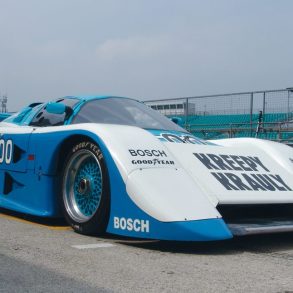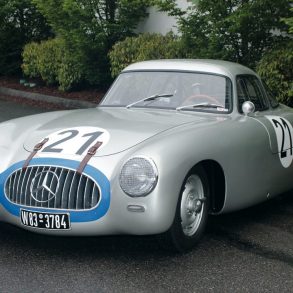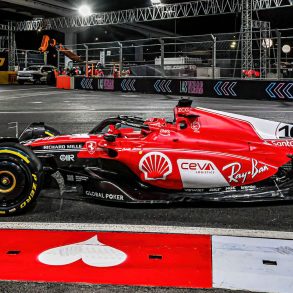Mario Andretti Biography
Mario Andretti was born in Montona, Italy, on February 28, 1940, just three months before Mussolini worked up the courage to throw in his lot with Hitler, and thrust Italy into World War II. At the cessation of hostilities the Andrettis found that their homeland was destined to become part of post-war Yugoslavia. They became refugees from Communism, spending several years in a camp at Tuscani. In 1954 Mario’s interest in motor racing was quickened by a visit to Monza to see the great Ascari compete in the Italian Grand Prix. The following year his family emigrated to the United States, making their new home in Nazareth, Pennsylvania.

Unfortunately, an accident put a premature end to Aldo’s career. Mario, however, kept on. On a single autumn day in 1963 he won three midget races on 2 separate tracks. In 1964 he began competing in USAC sprint car and Indy car races. He had the maturity to turn down and Indianapolis 500 ride that year, feeling that he needed more racing experience. When he did enter the Big Race for the first time the next year, he took third and Rookie of the Year honors.


Prior to 1976 one might have wagered money that, should Andretti be destined to achieve great things in F1, considering his background the fates would decree that it be with the Prancing Horse of Maranello. Curiously, though, this was not to be. He left Ferrari at the end of 1972, and when a 2 year ride (he skipped the ’73 season to concentrate on USAC events) in the eminently forgettable Parnelli evaporated with that team early in ’76, it was back to Lotus that he turned for his next F1 opportunity. Andretti’s hook-up with Colin Chapman at Long Beach was a godsend to both. The then out-of-luck Andretti eventually got a fabulous car – the ground effects Lotus 79 – with which to win the ’78 championship. The then out-of-luck Chapman got a no-nonsense driver with the critical eye and gritty determination required to shake out both Team Lotus and its suspect cars.
Andretti declared the 1976 Lotus 77 to be a dog, but won a pole and race with it anyway, both at Japan. In 1977 Chapman pulled out of his magic hat the Lotus 78, the first real “wing car.” Andretti piloted it to victory at Long Beach, and it looked so promising early in the year that people started talking championship for him and Lotus. Its season sank, however, following teething problems with a new version of the Cosworth engine.
The 78 carried Andretti and Lotus through the first 5 races of 1978 gaining him 1 victory. Zolder was the debut of the Lotus 79, the ultimate in ground effects. In an accomplishment reminiscent of the Lotus 49 at Zandvoort 11 years earlier, the 79 took pole and the win its first time out. Andretti kept it up with wins at Spain, France, Germany and Holland. So dominant was Lotus in 1978 that Andretti’s major competition for the title was his teammate, SuperSwede Ronnie Peterson. Andretti came to Monza leading Peterson by 12 points. At the start, James Hunt was punted into Peterson by another car. Peterson’s car in turn hit the Armco heavily and burst into flames. The race was red-flagged as Hunt, Patrick Depailler, Clay Regazzoni and race marshals worked bravely to free Peterson.
The accident had been frightening to witness, but Peterson was taken away to the hospital with only severely broken legs and minor burns. Andretti made the second start thinking that his teammate was going to be OK. After chasing down Gilles Villeneuve and finishing first on the track, Andretti was relegated to sixth for jumping the restart. This was sufficient, though, under the circumstances, to clinch the championship.

Some may argue that Andretti rode the phenomenal 79 to his championship. But it should be remembered that the 79, like most of Chapman’s cars, existed just this side of the line dividing the unconquerable from the undrivable. Merely setting up a Lotus was often enough to drive strong men to distraction. Andretti joined Moss, Clark, Graham Hill, Rindt, Fittipaldi and Peterson in the select group possessing sufficient skill to bring schizophrenic Lotus machinery to near its full potential.
Andretti had won his last F1 race. He competed for 4 more seasons, 2 with Lotus, 1 with Alfa Romeo, and 3 races in 1982 with Williams and, once again, Ferrari. At Monza that year, his next to last F1 race, he very authoritatively put his Ferrari on the pole to the delight of the tifosi, amongst who’s ranks he had once been numbered. Typical Andretti – going out with class.
At 42 Andretti was a little long in the tooth for an F1 driver, but his racing career was far from over. For more than a decade he continued to threaten a second victory at Indy. He had the privilege of going wheel-to-wheel with his son, Michael, in Indy cars. In 1992 at the age of 52 he captured a 230 mph pole at Michigan International Speedway. Driving high performance race cars is a severe physical and psychological challenge. Just going at very high speed inflicts extreme stress on a driver’s body. Many wondered how long Andretti would continue, or, for that matter, how he had continued for so long.
Andretti’s Italian-American drawl and legendary coolness behind the wheel hid a fierce competitive spirit. It is possible that no other driver in the history of motor racing has had as much success while simultaneously having to put out as much effort for that success. Andretti’s physical and mental makeup were perfectly suited, as perhaps no other driver’s has been, to the demands of racing. Through all those years and all those trials Andretti was never petulant, juvenile or devious, which is a great deal more than can be said for a lot of other top rank drivers in the Grand Prix pressure cooker. Sure he could lose his temper on occasion. Making your living at 170 mph will cause that. But his behavior was invariably a credit to his profession.
Despite a career that touched 5 decades, Andretti did not, at the end, fade away into obscurity. He would never have tolerated that. He was still winning in his 50’s. At Phoenix in 1993, the year of his son’s abortive try at F1, he took his last Indy car victory. As this is written it is not at all certain that at some time he won’t turn up again at, say, Le Mans to give his competitive instincts a little more exercise. But, of course, only if he has a chance to win. We might see Mario Andretti at the wheel of a race car in his 90’s.























